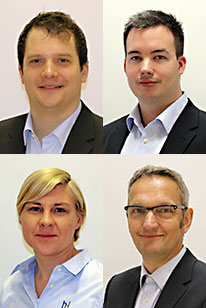Membrane degassing
Membrane degassing enables carbon dioxide (CO2) to be removed from water in pure stripping air mode down to values of less than 2 mg/l (ppm) or in combination with a vacuum pump to values of less than 1 mg/l (ppm).
Using industrial nitrogen as the stripping medium and in combination with a vacuum pump enables oxygen (O2) to be reduced to residual values of less than 1 µg/l (ppb), as is required in the semiconductors industry for example.
Membrane degassing is a very effective degassing method. It also supports desalination processes.
The individual hollow-fibre membranes are combined in modules (known as membrane contactors). Initially, the liquid flows via the contactor's inlet nozzles into a distributor pipe and is directed along the hollow fibres by a deflection barrier so that the gases can penetrate into the hollow fibres. The degassed liquid then leaves the contactor via a manifold and the subsequent outlet nozzle. In the counter-current, the stripping gas is directed through the hollow fibres via two separate nozzles on the inside. Depending on what is required in terms of gas outlet concentration and treatment volume, individual contactors are connected either in series or, in the case of a high volume flow, also in parallel.
A membrane degassing system basically consists of:
- Membrane contactors
- Prefilter with 3 µm filter fineness for stripping gas
- Prefilter with 5 µm filter fineness for the liquid being degassed
- Measuring instruments and valves
- Frame and piping
- Components for the stripping gas
- Vacuum pumps / fan
- Pipelines
In addition, membrane degassing is useful between reverse osmosis and electrodeionisation (EDI). Firstly, free carbon dioxide passes the membranes of the reverse osmosis system, and secondly the shift in the lime-carbonic acid equilibrium releases additional carbon dioxide. This places a great load on the downstream EDI. Here, membrane degassing is an ideal addition between reverse osmosis and EDI, as it reliably removes CO2 from the reverse osmosis permeate.
Operating conditions
The water flowing in should at least be decarbonised (partially desalinated) or softened, since during degassing hardeners precipitate and the membrane fibres can block up (scaling) due to the shift in the lime-carbonic acid equilibrium. As many undissolved substances as possible must also be removed by filtration, otherwise they will also cause blockages (fouling).
For striping gas operation (with CO2 removal), the media temperature should be 30 °C maximum. Higher operating temperatures (up to 60 °C) are possible when nitrogen is used as the stripping gas (for O2 removal).
Special application:
- Demineralisation with Ion exchange
- Reverse osmosis and EDI (Electrodeionization)
We would be pleased to provide further information on request. For very detailed information about the design of the systems and components please refer to the PDF file in the download area.
Or even better: Call us.


